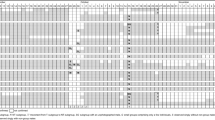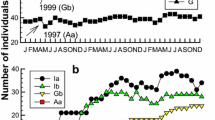Abstract
In 1986, the Japanese macaques of Arashiyama B group fissioned into Arashiyama E and F groups through the following process. In December 1985, the death of the beta male triggered aggressive interactions among the adult males of B group, leading to a decline in the ranks of two mid-ranked males. Several females started to gather around these two males, formed a stable subgroup (here called the female cluster), and spatially distanced themselves from other group members (main group). Some of these females had mating relations with these two males in previous mating seasons. After the end of the 1985–86 mating season, agonistic interactions occurred frequently between the female cluster and main group. Eventually, two independent groups were established. The females within the 4th degrees of matrilineal consanguinity tended to belong to the same group, but no such tendency occurred in those dyads separated by the 5th or more degrees. After the completion of group fission, mating occurred only a few times between E and F group members. In 1986, when the group fission was in progress, the birth rate of both branch groups declined, and infant mortality increased in E group. After 1987, the birth rate recovered in both branch groups although infant mortality remained high.



Similar content being viewed by others
References
Altmann J (1974) Observational study of behavior: sampling methods. Behaviour 49:227–266
Chepko-Sade BD, Sade DS (1979) Patterns of group splitting within matrilineal kinship groups: a study of social group structure in Macaca mulatta (Cercopithecidae: Primates). Behav Ecol Sociobiol 5:67–86
Cords M (2012) The 30-year blues: what we know and don’t know about life history, group size, and group fission of blue monkeys in the Kakamega Forest, Kenya. In: Kappeler PM, Watts DP (eds) Long-term field studies of primates. Springer, Heidelberg, pp 289–311
Dittus WPJ (1988) Group fission among wild toque macaques as a consequence of female resource competition and environmental stress. Anim Behav 36:1626–1645
Fedigan LM (1991) History of the Arashiyama West Japanese Macaques in Texas. In: Asquith PJ (ed) Fedigan LM. The monkeys of Arashiyama. thirty-five years of research in Japan and the West. State University of New York Press, New York pp, pp 54–73
Fukuda F (1988) Influence of artificial food supply on population parameters and dispersal in the Hakone T troop of Japanese macaques. Primates 29:477–492
Furuya Y (1969) On the fission of troops of Japanese monkeys II: general view of troop fission of Japanese monkeys. Primates 10:47–69
Hsu MJ, Lin JF, Agoramoorthy G (2017) Social implications of fission in wild Formosan macaques at Mount Longevity. Taiwan Primates 58:323–334
Huffman MA (1991) History of the Arashiyama Japanese macaques in Kyoto, Japan. In: Asquith PJ (ed) Fedigan LM. The monkeys of Arashiyama. thirty-five years of research in Japan and the West. State University of New York Press, New York pp, pp 21–53
Huffman MA, Takahata Y (2012) Long-term trends in the mating relationships of Japanese macaques at Arashiyama, Japan. In: Leca JB, Huffman MA, Vasey PL (eds) The monkeys of stormy mountain:60 years of primatological research on the Japanese macaques of Arashiyama. Cambridge University Press, Cambridge, pp 71–86
Janson CH, Baldovino MC, Bitetti MD (2012) The group life cycle and demography of brown capuchin monkeys (Cebus [apella] nigritus) in Iguazu National Park, Argentina. In: Kapeller PM, Watts DP (eds) Long-term filed studies of primates. Springer-Verlag, Heidelberg, pp 185–212
Koyama N (1967) On dominance rank and kinship of a wild Japanese monkey troop in Arashiyama. Primates 8:189–216
Koyama N (1970) Changes in dominance rank and division of a wild Japanese monkey troop in Arashiyama. Primates 11:335–390
Ménard N, Vallet D (1993) Dynamics of fission in a wild Barbary macaque group (Macaca sylvanus). Int J Primatol 14:479–500
Okamoto K, Matsumura S (2001) Group fission in moor macaques (Macaca maurus). Int J Primatol 22:481–493
Silk JB (2002) Kin selection in primate groups. Int J Primatol 23:849–875
Sugiyama Y (1960) On the division of a natural troop of Japanese monkeys at Takasakiyama. Primates 2:109–148
Sugiyama Y, Ohsawa H (1982) Population dynamics of Japanese macaques at Ryozenyama III. Female desertion of the troop. Primates 23:31–44
Takahata Y (1980) The reproductive biology of a free-ranging troop of Japanese monkeys. Primates 21:303–329
Takahata Y (1982) Social relations between adult males and females of Japanese monkeys in the Arashiyama B troop. Primates 23:1–23
Takahata Y (1991) Diachronic changes in the dominance relations of adult female Japanese monkeys of the Arashiyama B group. In: Fedigan LM, Asquith PJ (eds) The monkeys of Arashiyama: thirty-five years of research in Japan and the West. State University of New York Press, Albany, pp 123–139
Takahata Y, Suzuki S, Okayasu N, Sugiura H, Takahashi H, Yamagiwa J, Izawa K, Agetsuma N, Hill D, Saito C, Sato S, Tanaka T, Sprague D (1998) Does troop size of wild Japanese macaques influence birth rate and infant mortality in the absence of predators? Primates 39:245–251
Tsuji Y, Sugiyama Y (2014) Female emigration in Japanese macaques, Macaca fuscata: ecological and social backgrounds and its biogeographical implications. Mammalia 78:281–290
Van Horn RC, Buchan JC, Altmann J, Alberts SC (2007) Divided destinies: group choice by female savannah baboons during social group fission. Behav Ecol Sociobiol 61:1823–1837
van Schaik CP (1983) Why are diurnal primates living in groups? Behaviour 87:120–144
Widdig A, Nürnberg P, Bercovitch FB, Trefilov A, Berard JB, Kessler MJ, Schmidtke J, Streich WJ, Krawczak M (2006) Consequences of group fission for the patterns of relatedness among rhesus macaques. Mol Ecol 15:3825–3832
Wrangham RW (1980) An ecological model of female-bonded primate groups. Behaviour 75:262–300
Acknowledgements
We deeply thank Hidetoshi Ota, the late Toshifumi Wada, Mayumi Yokoyama, Yoshiki Morimitsu, and Takeo Kuriyama of Institute of Natural and Environmental Sciences, University of Hyogo for their kind instructions and useful comments; Masayuki Nakamichi of the Institute of Human Sciences, Osaka University, for providing unpublished data; The late Nobuo Asaba (former director of the park), his son’s Shinsuke Asaba and Ryosuke Asaba, the late Kazuko Kanbara, and others of the Iwatayama Monkey Park, for their kind cooperation, advice, and providing demographic data. We thank our two reviewers for their thoughtful and constructive comments. We also thank MARUZEN-YUSHODO Co., Ltd. (https://kw.maruzen.co.jp/kousei-honyaku/) for the English language editing of the first version. Last, we whole-heartedly thank the monkeys of Arashiyama for the opportunity to learn about their lives.
Author information
Authors and Affiliations
Corresponding author
Additional information
Publisher's Note
Springer Nature remains neutral with regard to jurisdictional claims in published maps and institutional affiliations.
About this article
Cite this article
Suzuki, H., Huffman, M.A. & Takahata, Y. Process of Japanese macaque group fission at Arashiyama and the influences of maternal kin relations and social relations between adult males and females on it. Primates 64, 79–90 (2023). https://doi.org/10.1007/s10329-022-01024-x
Received:
Accepted:
Published:
Issue Date:
DOI: https://doi.org/10.1007/s10329-022-01024-x




